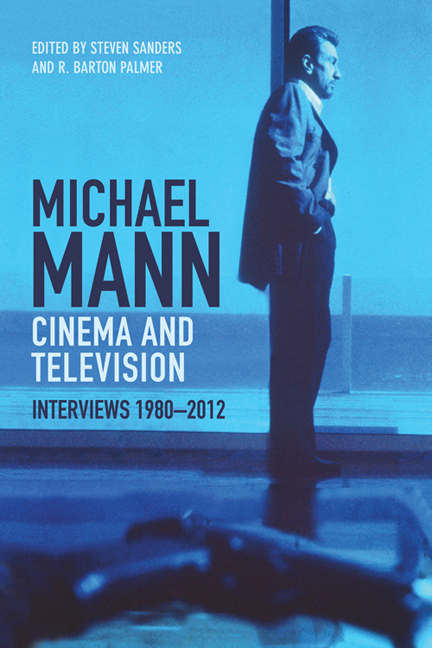Book contents
- Frontmatter
- Contents
- List of Illustrations
- Acknowledgements
- Introduction: Michael Mann in His Interviews
- 1 Four Minute Mile
- 2 Castle Keep
- 3 Of Vice and Mann
- 4 Manhunter: An Interview with Michael Mann
- 5 Michael Mann: Hollywood Writer–Director–Producer
- 6 Mann and His Movies
- 7 All the Corporations’ Men
- 8 Smoking Gun
- 9 “Ali Likes the Film a Lot. He's Seen it Six Times”
- 10 Paint it Black
- 11 Mann Among Men
- 12 L.A. Belongs to the Coyotes
- 13 Michael Mann Interview
- 14 A Mann's Man's World
- 15 Number One with a Bullet
- 16 The Study of Mann
- Chronology
- Filmography
- Publisher's Acknowledgments
- Index
10 - Paint it Black
Published online by Cambridge University Press: 05 September 2016
- Frontmatter
- Contents
- List of Illustrations
- Acknowledgements
- Introduction: Michael Mann in His Interviews
- 1 Four Minute Mile
- 2 Castle Keep
- 3 Of Vice and Mann
- 4 Manhunter: An Interview with Michael Mann
- 5 Michael Mann: Hollywood Writer–Director–Producer
- 6 Mann and His Movies
- 7 All the Corporations’ Men
- 8 Smoking Gun
- 9 “Ali Likes the Film a Lot. He's Seen it Six Times”
- 10 Paint it Black
- 11 Mann Among Men
- 12 L.A. Belongs to the Coyotes
- 13 Michael Mann Interview
- 14 A Mann's Man's World
- 15 Number One with a Bullet
- 16 The Study of Mann
- Chronology
- Filmography
- Publisher's Acknowledgments
- Index
Summary
Mark Olsen: In Collateral you seem to be exploring the aesthetics of DV. Was that one of the things that attracted you?
Michael Mann: It's useful here to make an analogy with architecture. When steel was first introduced as a building material architects disguised the structure of their buildings to look like masonry. It wasn't until Louis Sullivan's pioneering work in Chicago in the 1890s that the aesthetics of the steel structure were allowed to be expressed.
So my reason for choosing DV wasn't economy but was to do with the fact that the entire movie takes place in one city, on one night, and you can't see the city at night on motion-picture film the way you can on digital video. And I like the truth-telling feeling I receive when there's very little light on the actors’ faces – I think this is the first serious major motion picture done in digital video that is photoreal, rather than using it for effects. DV is also a more painterly medium: you can see what you've done as you shoot because you have the end product sitting in front of you on a Sony high-def monitor, so I could change the contrast to affect the mood, add color, do all kinds of things you can't do with film. Digital isn't a medium for directors who aren't interested in visualization, who rely on a set of conventions or aesthetic pre-sets, if you like. But it's perfect for someone like David Fincher or Ridley Scott – directors who pre-visualize and know just what they want to achieve.
MO: Did digital allow you to use a smaller crew or make the production more mobile?
MM: Not the way we did it. We had a whole film complement working alongside us so we could shoot in either medium. If we could shoot on film, we did, though in the end 80 per cent of the movie was shot on video. For instance, the shootout in the Korean disco was done on film because we were on a big interior set that had to be lit and we could move around more freely with the camera on our shoulder shooting 35mm than we could using digital.
- Type
- Chapter
- Information
- Michael Mann - Cinema and TelevisionInterviews, 1980-2012, pp. 81 - 84Publisher: Edinburgh University PressPrint publication year: 2014

